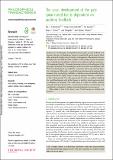Files in this item
The vocal development of the pale spear-nosed bat is dependent on auditory feedback
Item metadata
| dc.contributor.author | Lattenkamp, Ella Z. | |
| dc.contributor.author | Linnenschmidt, Meike | |
| dc.contributor.author | Mardus, Eva | |
| dc.contributor.author | Vernes, Sonja C. | |
| dc.contributor.author | Wiegrebe, Lutz | |
| dc.contributor.author | Schutte, Michael | |
| dc.date.accessioned | 2021-09-07T09:30:23Z | |
| dc.date.available | 2021-09-07T09:30:23Z | |
| dc.date.issued | 2021-10-25 | |
| dc.identifier | 275773302 | |
| dc.identifier | ba7e064e-f43a-45dd-b49d-e818833efaf1 | |
| dc.identifier | 000693558500005 | |
| dc.identifier | 85115818258 | |
| dc.identifier.citation | Lattenkamp , E Z , Linnenschmidt , M , Mardus , E , Vernes , S C , Wiegrebe , L & Schutte , M 2021 , ' The vocal development of the pale spear-nosed bat is dependent on auditory feedback ' , Philosophical Transactions of the Royal Society B: Biological Sciences , vol. 376 , no. 1836 , 20200253 . https://doi.org/10.1098/rstb.2020.0253 | en |
| dc.identifier.issn | 0962-8436 | |
| dc.identifier.other | RIS: urn:1A2D91D145ADFB8599D4ECF1126D3AA7 | |
| dc.identifier.other | ORCID: /0000-0003-0305-4584/work/99804767 | |
| dc.identifier.uri | https://hdl.handle.net/10023/23915 | |
| dc.description | Funding: The research was funded by the Human Frontiers Science Program (grant no. RGP0058/2016), awarded to L.W. and S.C.V. S.C.V. was supported by a Max Planck Research Group (MPRG) and a UKRI Future Leaders Fellowship (MR/T021985/1). M.S. was funded by a grant from Deutsche Forschungsgemeinschaft (no. wi1518/17). | en |
| dc.description.abstract | Human vocal development and speech learning require acoustic feedback, and humans who are born deaf do not acquire a normal adult speech capacity. Most other mammals display a largely innate vocal repertoire. Like humans, bats are thought to be one of the few taxa capable of vocal learning as they can acquire new vocalizations by modifying vocalizations according to auditory experiences. We investigated the effect of acoustic deafening on the vocal development of the pale spear-nosed bat. Three juvenile pale spear-nosed bats were deafened, and their vocal development was studied in comparison with an age-matched, hearing control group. The results show that during development the deafened bats increased their vocal activity, and their vocalizations were substantially altered, being much shorter, higher in pitch, and more aperiodic than the vocalizations of the control animals. The pale spear-nosed bat relies on auditory feedback for vocal development and, in the absence of auditory input, species-atypical vocalizations are acquired. This work serves as a basis for further research using the pale spear-nosed bat as a mammalian model for vocal learning, and contributes to comparative studies on hearing impairment across species. | |
| dc.format.extent | 6 | |
| dc.format.extent | 781394 | |
| dc.language.iso | eng | |
| dc.relation.ispartof | Philosophical Transactions of the Royal Society B: Biological Sciences | en |
| dc.subject | Vocal development | en |
| dc.subject | Vocal learning | en |
| dc.subject | Deafening | en |
| dc.subject | Auditory feedback | en |
| dc.subject | Hearing impairment | en |
| dc.subject | QH301 Biology | en |
| dc.subject | QL Zoology | en |
| dc.subject | DAS | en |
| dc.subject.lcc | QH301 | en |
| dc.subject.lcc | QL | en |
| dc.title | The vocal development of the pale spear-nosed bat is dependent on auditory feedback | en |
| dc.type | Journal article | en |
| dc.contributor.sponsor | UK Research and Innovation | en |
| dc.contributor.institution | University of St Andrews. School of Biology | en |
| dc.contributor.institution | University of St Andrews. St Andrews Bioinformatics Unit | en |
| dc.identifier.doi | 10.1098/rstb.2020.0253 | |
| dc.description.status | Peer reviewed | en |
| dc.identifier.grantnumber | MR/T021985/1 | en |
This item appears in the following Collection(s)
Items in the St Andrews Research Repository are protected by copyright, with all rights reserved, unless otherwise indicated.

